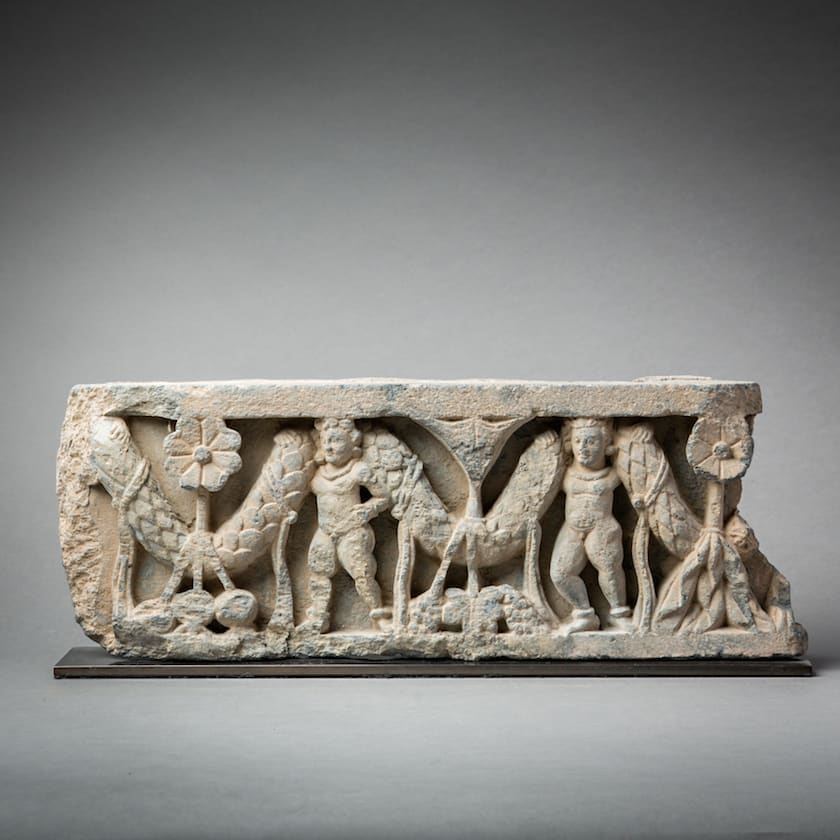Frieze with Putti and Garlands, 2nd Century CE - 3rd Century CE
gray schist
43.2 x 16.5 cm
17 x 6 1/2 in
17 x 6 1/2 in
LO.1060
Part of a recurring band of decoration, which would have divided two panels, this grey schist relief shows two putti holding a garland of flowers amidst lotuses springing vertically from...
Part of a recurring band of decoration, which would have divided two panels, this grey schist relief shows two putti holding a garland of flowers amidst lotuses springing vertically from the earth. The putti are captured walking in one direction with their torso and head in three-quarter view. The motif of the garland as well as the putti have been drawn from the classical artistic repertoire, as this motif constituted the principal decoration of hundreds of Roman sarcophagi. It was thus introduced by Roman Eurasian artists in the service of the Kushan court, who governed Gandhara and actively sponsored its Buddhist faith between the 2nd and the 6th century AD.
The Gandhara region had long been a crossroads of cultural influences. Geographically it included northwestern India between the Khyber Pass and the Indus River and the region of the Kabul Valley in Afghanistan. During the reign of Kanishka (AD 129-160) the Kushans maintained contacts with Rome and employed foreign artists from the eastern centres of the Roman Empire to realise many sculptural works. The many archaeological discoveries of Alexandrian and Syrian workmanship at Taxila in the Punjab and Begram in the Kabul valley testify to the cultural and diplomatic connections with the Graeco-Roman West.
Throughout classical art, putti are depicted as fat, mischievous children whilst in Indian art they are often represented as naughty dwarves. Yet in Gandharan art nudity is seldom expressed and perhaps one of the few exceptions is represented by the theme of Eros and the garland, of which the putti are a direct emanation. In this scene these small putti provide relief to the seriousness of the underlying religious imagery evident in the symbolism of the lotus flower, a reoccuring reference to the purity of the Buddha, rising as it does from the mud of the lake bottom to flower on the surface unsullied.
The Gandhara region had long been a crossroads of cultural influences. Geographically it included northwestern India between the Khyber Pass and the Indus River and the region of the Kabul Valley in Afghanistan. During the reign of Kanishka (AD 129-160) the Kushans maintained contacts with Rome and employed foreign artists from the eastern centres of the Roman Empire to realise many sculptural works. The many archaeological discoveries of Alexandrian and Syrian workmanship at Taxila in the Punjab and Begram in the Kabul valley testify to the cultural and diplomatic connections with the Graeco-Roman West.
Throughout classical art, putti are depicted as fat, mischievous children whilst in Indian art they are often represented as naughty dwarves. Yet in Gandharan art nudity is seldom expressed and perhaps one of the few exceptions is represented by the theme of Eros and the garland, of which the putti are a direct emanation. In this scene these small putti provide relief to the seriousness of the underlying religious imagery evident in the symbolism of the lotus flower, a reoccuring reference to the purity of the Buddha, rising as it does from the mud of the lake bottom to flower on the surface unsullied.
